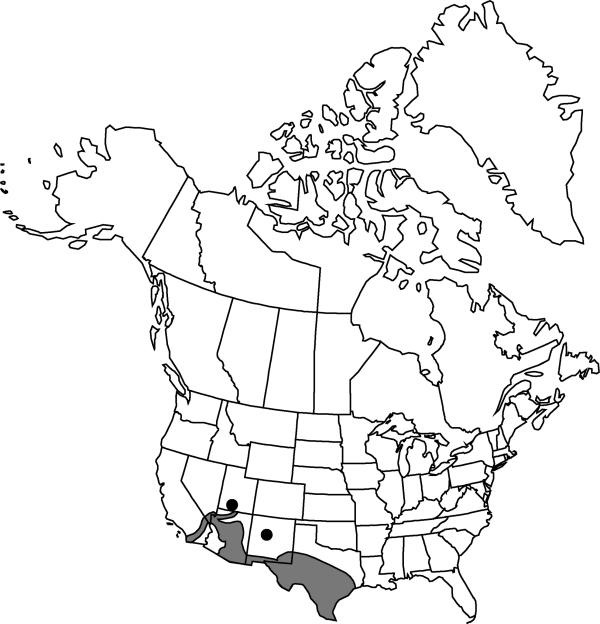Difference between revisions of "Opuntia engelmannii"
Boston J. Nat. Hist. 6: 207. 1850.
FNA>Volume Importer |
FNA>Volume Importer |
||
| Line 17: | Line 17: | ||
}}<!-- | }}<!-- | ||
| − | --><span class="statement" id="st- | + | --><span class="statement" id="st-undefined" data-properties=""><b>Shrubs </b>or trees, with short trunk, spreading to sometimes decumbent, 1–3 m. <b>Stem</b> segments not disarticulating, yellow-green to blue-green, flattened, circular to obovate to rhombic, or apex tapering, elongate, 15–40(–120) × 10–40 cm, ± tuberculate, glabrous, often glaucous; areoles 5–8 per diagonal row across mid-stem segments, evenly distributed on stem segment to absent, subcircular to obovate, 4–7 × 4–6 mm; wool tawny, aging blackish. <b>Spines</b> (0–)1–6(–12) per areole, white to yellow, usually red to dark brown at extreme bases, aging gray to ± black, subulate, straight to curved, flattened to angular at least near base, the longest spreading to strongly reflexed, 10–30(–50) mm. <b>Glochids</b> widely spaced, sparse in crescent at adaxial edge, encircling areole or nearly so, and scattered in subapical tuft, yellow to red-brown, aging gray to blackish, of irregular lengths, to 10 mm. <b>Flowers</b>: inner tepals uniformly yellow to buff, sometimes orange to pink to red (rarely whitish), 30–40 mm; filaments, anthers, and style whitish to cream; stigma lobes yellow-green to green. <b>Fruits</b> dark red to purple throughout, sometimes stipitate, ovate-elongate to barrel-shaped, 35–90 × 20–40 mm, juicy (bleeding and staining), glabrous, spineless; areoles 20–32 usually toward apex. <b>Seeds</b> tan to grayish, subcircular to deltoid, flattened, 2.5–6 × 2–5 mm; girdle protruding 0.3–0.5 mm.</span><!-- |
-->{{Treatment/Body | -->{{Treatment/Body | ||
| Line 82: | Line 82: | ||
|publication year=1850 | |publication year=1850 | ||
|special status= | |special status= | ||
| − | |source xml=https://jpend@bitbucket.org/aafc-mbb/fna- | + | |source xml=https://jpend@bitbucket.org/aafc-mbb/fna-data-curation.git/src/9216fc802291cd3df363fd52122300479582ede7/coarse_grained_fna_xml/V4/V4_252.xml |
|subfamily=Cactaceae subfam. Opuntioideae | |subfamily=Cactaceae subfam. Opuntioideae | ||
|genus=Opuntia | |genus=Opuntia | ||
|species=Opuntia engelmannii | |species=Opuntia engelmannii | ||
| − | |||
| − | |||
| − | |||
| − | |||
| − | |||
| − | |||
| − | |||
| − | |||
| − | |||
| − | |||
| − | |||
| − | |||
| − | |||
| − | |||
| − | |||
| − | |||
| − | |||
| − | |||
| − | |||
| − | |||
| − | |||
| − | |||
| − | |||
| − | |||
| − | |||
| − | |||
| − | |||
| − | |||
| − | |||
| − | |||
| − | |||
| − | |||
| − | |||
| − | |||
| − | |||
| − | |||
| − | |||
| − | |||
| − | |||
| − | |||
| − | |||
| − | |||
| − | |||
| − | |||
| − | |||
| − | |||
| − | |||
| − | |||
| − | |||
| − | |||
| − | |||
| − | |||
| − | |||
}}<!-- | }}<!-- | ||
-->[[Category:Treatment]][[Category:Opuntia]] | -->[[Category:Treatment]][[Category:Opuntia]] | ||
Revision as of 15:01, 27 July 2019
Shrubs or trees, with short trunk, spreading to sometimes decumbent, 1–3 m. Stem segments not disarticulating, yellow-green to blue-green, flattened, circular to obovate to rhombic, or apex tapering, elongate, 15–40(–120) × 10–40 cm, ± tuberculate, glabrous, often glaucous; areoles 5–8 per diagonal row across mid-stem segments, evenly distributed on stem segment to absent, subcircular to obovate, 4–7 × 4–6 mm; wool tawny, aging blackish. Spines (0–)1–6(–12) per areole, white to yellow, usually red to dark brown at extreme bases, aging gray to ± black, subulate, straight to curved, flattened to angular at least near base, the longest spreading to strongly reflexed, 10–30(–50) mm. Glochids widely spaced, sparse in crescent at adaxial edge, encircling areole or nearly so, and scattered in subapical tuft, yellow to red-brown, aging gray to blackish, of irregular lengths, to 10 mm. Flowers: inner tepals uniformly yellow to buff, sometimes orange to pink to red (rarely whitish), 30–40 mm; filaments, anthers, and style whitish to cream; stigma lobes yellow-green to green. Fruits dark red to purple throughout, sometimes stipitate, ovate-elongate to barrel-shaped, 35–90 × 20–40 mm, juicy (bleeding and staining), glabrous, spineless; areoles 20–32 usually toward apex. Seeds tan to grayish, subcircular to deltoid, flattened, 2.5–6 × 2–5 mm; girdle protruding 0.3–0.5 mm.
Distribution

sc and sw United States, n Mexico.
Discussion
Varieties 5 (5 in the flora).
The basal portions of stems seedlings of Opuntia engelmannii bear long hairlike spines.
The name Opuntia dillei Griffiths has been used for a spineless or nearly spineless morphotype of O. engelmannii.
Selected References
None.
Lower Taxa
Key
| 1 | Stem segments becoming very elongate, 2+ times longer than wide, lanceolate to linear-lanceolate, often falcate | Opuntia engelmannii var. linguiformis |
| 1 | Stem segments to 1.5 times longer than wide, commonly circular to obovate to rhomboid | > 2 |
| 2 | Spines chalky white, yellow when wetted, with dark red-brown extreme bases. | Opuntia engelmannii var. engelmannii |
| 2 | Spines pale to dark yellow, not chalky white, at times with red-brown extreme bases | > 3 |
| 3 | Stem segments with spines straight or slightly curving, spreading | Opuntia engelmannii var. lindheim |
| 3 | Stem segments with spines strongly deflexed or arching downward near bases | > 4 |
| 4 | Spines arching downward near bases; sc Ari- zona | Opuntia engelmannii var. flavispi |
| 4 | Spines strongly deflexed; s Texas. | Opuntia engelmannii var. flexispi |